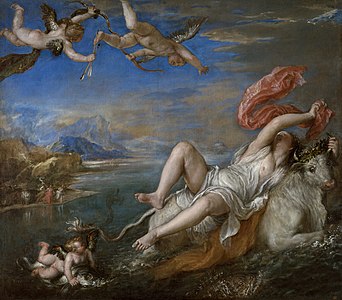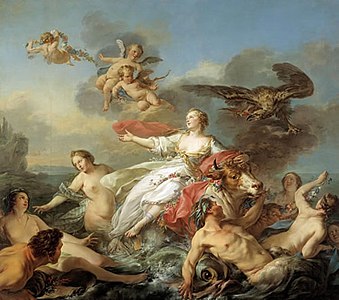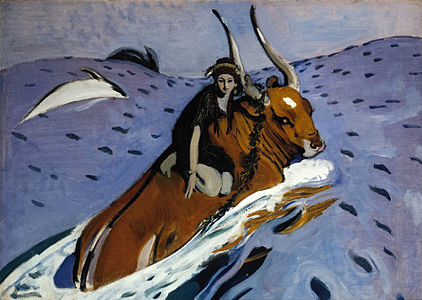Europa (consort of Zeus)
| Europa | |
|---|---|
In
Europa's earliest literary reference is in the Iliad, which is commonly dated to the 8th century BC.[2] Another early reference to her is in a fragment of the Hesiodic Catalogue of Women, discovered at Oxyrhynchus.[3] The earliest vase-painting securely identifiable as Europa dates from the mid-7th century BC.[4]
Etymology
It is common in ancient Greek mythology and geography to identify lands or rivers with female figures. Thus, Europa is first used in a geographic context in the
An alternative suggestion due to Ernest Klein and Giovanni Semerano (1966) attempted to connect a Semitic term for "west", Akkadian erebu meaning "to go down, set" (in reference to the sun), Phoenician 'ereb "evening; west", which would parallel occident (the resemblance to Erebus, from PIE *h1regʷos, "darkness", is accidental, however). Barry (1999) adduces the word Ereb on an Assyrian stele with the meaning of "night", "[the country of] sunset", in opposition to Asu "[the country of] sunrise", i.e. Asia (Anatolia coming equally from Ἀνατολή, "(sun)rise", "east").[10] This proposal is mostly considered unlikely or untenable.[note 1][11][12]
Family
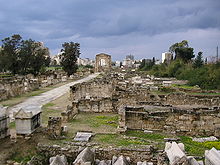
Sources differ in details regarding Europa's family, but agree that she is
| Relation | Names | Sources | ||||||||||||||
|---|---|---|---|---|---|---|---|---|---|---|---|---|---|---|---|---|
| Alcman | Hom. | Sch. Iliad | Hes. | Hella. | Bacchy. | Sch. Eurip | Mosc | Con | Diod. | Apollod. | Hyg. | Pau. | Non. | |||
| Parentage | Phoenix | ✓[note 3] | ✓ | ✓ | ✓[note 3] | ✓ | ✓ | |||||||||
| Phoenix and Cassiopeia | ✓ | |||||||||||||||
| Phoenix and Telephassa | ✓ | |||||||||||||||
| Phoenix and Telephe | ✓ | |||||||||||||||
| Phoenix and Perimede | ✓ | |||||||||||||||
| Agenor | ✓ | |||||||||||||||
| Agenor and Telephassa | ✓ | |||||||||||||||
| Agenor and Argiope | ✓ | ✓ | ||||||||||||||
| Siblings | Phineus | ✓ | ✓[note 4] | ✓ | ||||||||||||
| Astypale | ✓ | ✓ | ||||||||||||||
| Phoenice | ✓ | |||||||||||||||
| Peirus | ✓ | |||||||||||||||
| Cadmus | ✓ | ✓ | ✓ | ✓ | ✓ | ✓ | ✓ | |||||||||
| Thasus | ✓ | |||||||||||||||
| Phoenix | ✓ | |||||||||||||||
| Cilix | ✓ | |||||||||||||||
| Adonis | ✓ | |||||||||||||||
| Consorts | Zeus | ✓ | ✓ | ✓ | ||||||||||||
| Asterius | ✓ | |||||||||||||||
| Children | Minos | ✓ | ✓[note 5] | ✓ | ✓ | |||||||||||
| Rhadamanthys | ✓ | ✓ | ||||||||||||||
| Sarpedon | ✓ | |||||||||||||||
| Carnus | ✓ | |||||||||||||||
Mythology

The Dictionary of Classical Mythology explains that Zeus was enamoured of Europa and decided to seduce or rape her, the two being near-equivalent in Greek myth.
The myth of Europa and Zeus may have its origin in a sacred union between the Phoenician deities
According to Herodotus' rationalizing approach, Europa was kidnapped by Greeks (probably Cretans), who were seeking to avenge the kidnapping of Io, a princess from Argos. His variant story may have been an attempt to rationalize the earlier myth; or the present myth may be a garbled version of facts—the abduction of a Phoenician aristocrat—later enunciated without gloss by Herodotus.
Cult
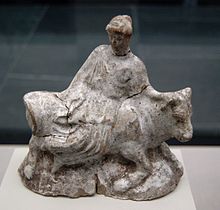
Astarte and Europa
In the territory of Phoenician
- There is likewise in Phœnicia a temple of great size owned by the Sidonians. They call it the temple of Astarte. I hold this Astarte to be no other than the moon-goddess. But according to the story of one of the priests this temple is sacred to Europa, the sister of Cadmus. She was the daughter of Agenor, and on her disappearance from Earth the Phœnicians honoured her with a temple and told a sacred legend about her; how that Zeus was enamoured of her for her beauty, and changing his form into that of a bull carried her off into Crete. This legend I heard from other Phœnicians as well; and the coinage current among the Sidonians bears upon it the effigy of Europa sitting upon a bull, none other than Zeus. Thus they do not agree that the temple in question is sacred to Europa.[13] [verification needed]
The paradox, as it seemed to Lucian, would be solved if Europa is Astarte in her guise as the full, "broad-faced" moon.
Interpretation
There were two competing myths
Europa does not seem to have been venerated directly in
The festival of Hellotia in Crete was celebrated in honour of Europa.[24][25]
Argive genealogy
|
In art and literature

Europa provided the substance of a brief
In
|
His picturesque details belong to anecdote and fable: in all the depictions, whether she straddles the bull, as in archaic vase-paintings or the ruined metope fragment from
Her tale is also mentioned in Nathaniel Hawthorne's Tanglewood Tales. Though his story titled "Dragon's teeth" is largely about Cadmus, it begins with an elaborate albeit toned down version of Europa's abduction by the beautiful bull.
The tale also features as the subject of a poem and film in the
Gallery
-
Europa velificans, "her fluttering tunic… in the breeze" (mosaic, Zeugma Mosaic Museum)
-
The Rape of Europa by Titian (1562)
-
The Rape of Europa by François Chauveau (1650)
-
The Rape of Europa by Jean-Baptiste Marie Pierre (1750)
-
The Rape of Europa by Francisco Goya(1772)
-
The Rape of Europa by Félix Vallotton (1908)
-
The Rape of Europa by Valentin Serov (1910)
-
Europa on the Bull by Carl Milles (1926)
-
Rapto de Europa by Juan Oliveira Viéitez (1989)
-
Europa by Léon de Pas (1997)
-
Europe by May Claerhout (1999)
Namesakes

Continent
The name
It is derived from the Greek word Eurōpē (Εὐρώπη) in all Romance languages, Germanic languages, Slavic languages, Baltic languages, Celtic languages, Iranian languages, Uralic languages (Hungarian Európa, Finnish Eurooppa, Estonian Euroopa).

Jürgen Fischer, in Oriens-Occidens-Europa[30] summarized how the name came into use, supplanting the oriens–occidens dichotomy of the later Roman Empire, which was expressive of a divided empire, Latin in the West, Greek in the East.
In the 8th century, ecclesiastical uses of "Europa" for the imperium of
The European Union has also used Europa as a symbol of pan-Europeanism, notably by naming its web portal after her and depicting her on the Greek €2 coin and on several gold and silver commemorative coins (e.g. the Belgian €10 European Expansion coin). Her name appeared on postage stamps celebrating the Council of Europe, which were first issued in 1956. The second series of euro banknotes is known as the Europa Series and bears her likeness in the watermark and hologram.

Chemical element
The metal europium, a rare-earth element, was named in 1901 after the continent.[32]
Moon of Jupiter
The invention of the
Notes
- ISBN 0-19-815221-3..
- ^ Kerenyi points out that these names are attributes of the moon, as is Europa's broad countenance.
- ^ a b Though Europa was unnamed in this text, she must be the daughter of Phoenix who coupled with Zeus.
- ^ Even though Phineus was called the son of Agenor according to Apollodorus, his mother may be different because only three sons (Cadmus, Phoenix and Cilix) were born to Agenor and Telephassa.
- ^ Unnamed but pertains to Minos who was king of Crete
- ISBN 0691029156. Pausaniasrendered the name Asterion (2.31.1); in Bibliotheke (3.1.4) it is Asterion.
- ^ Herodotus, Histories I.1; the act is made out to be a revenge for the previous "kidnapping" of Io.
- S2CID 244492052.; I. E. S. Edwards, ed. The Cambridge Ancient History, plates to vols. V and VI 1970:illus. fig. 24.
- ^ The poem was published with voluminous notes and critical apparatus: Winfried Bühler, Die Europa des Moschos (Wiesbaden: Steiner) 1960.
References
- Kerenyi, Karl(1951). The Gods of the Greeks. Thames and Hudson. p. 108.
- ^ Pierre Vidal-Naquet, Le monde d'Homère, Perrin 2000:19; M.I. Finley, The World of Odysseus, (1954) 1978:16 gives "the years between 750 and 700 BC, or a bit later".
- ^ a b c Hesiodic papyrus fragments 19 and 19A Archived 2021-12-22 at the Wayback Machine of the Catalogue of Women, dating from the third century AD.
- ^ Walter Burkert, Greek Religion (1985) I.3.2, note 20, referring to Schefold, plate 11B. References in myth and art have been assembled by W. Bühler, Europa: eine Sammlung der Zeugnisse des Mythos in der antiken Litteratur und Kunst (1967).
- ^ εὐρύς Archived 2021-12-22 at the Wayback Machine, Henry George Liddell, Robert Scott, A Greek-English Lexicon, on Perseus
- ^ ὤψ Archived 2021-12-22 at the Wayback Machine, Henry George Liddell, Robert Scott, A Greek-English Lexicon, on Perseus
- ISBN 978-0-19-928075-9.. Compare also glaukōpis (γλαυκῶπις 'grey-eyed') Athena or boōpis (βοὠπις 'ox-eyed') Hera).
- ^ Τελφοῦσ᾽, ἐνθάδε δὴ φρονέω περικαλλέα νηὸν / ἀνθρώπων τεῦξαι χρηστήριον, οἵτε μοι αἰεὶ ἐνθάδ᾽ ἀγινήσουσι τεληέσσας ἑκατόμβας, / ἠμὲν ὅσοι Πελοπόννησον πίειραν ἔχουσιν / ἠδ᾽ ὅσοι Εὐρώπην τε καὶ ἀμφιρύτας κατὰ νήσους "Telphusa, here I am minded to make a glorious temple, an oracle for men, and hither they will always bring perfect hecatombs, both those who live in rich Peloponnesus and those of Europe and all the wave-washed isles, coming to seek oracles." (verses 247–251, trans. Hugh G. Evelyn-White).
- ^ Histories 4.38. C.f. James Rennell, The geographical system of Herodotus examined and explained, Volume 1, Rivington 1830, p. 244
- ISBN 978-2-7103-0937-6
- JSTOR i222266.
- New International Encyclopedia(1st ed.). New York: Dodd, Mead.
- ^ a b c "Europa (mythology)". Encarta. Microsoft Corporation. 2008.
- ^ Moschus, Europa (on-line text at Theoi Project Archived 2021-05-03 at the Wayback Machine).
- ^ Homer, Iliad, Book 14, line 321. Archived from the original on 2022-01-04. Retrieved 2022-01-04.
- ^ Scholia on Homer, Iliad B, 494, p. 80, 43 ed. Bekk. as cited in Hellanicus' Boeotica
- ^ Pseudo-Apollonius, Bibliotheke 3.1.1.
- ^ Pausanias, Graeciae Descriptio 3.13.5
- OCLC 25246340.
- ISBN 978-0-19-159104-4. Archivedfrom the original on 22 December 2021. Retrieved 17 March 2022.
- ^ Bibliotheke 3.1.1.
- ^ "The Designer: And if Europe was Sidonian?". Lorientjour.com. Archived from the original on 2013-05-25. Retrieved 2012-11-28.
- ^ Pausanias, Guide to Greece 9.39.2–5.
- archive.org.
- ^ A Dictionary of Greek and Roman Antiquities (1890), Ellotia
- ISBN 0-674-01130-9.
- ^ Strabo, Geography 8.1.1 Archived 2008-10-08 at the Wayback Machine.
- ^ "Thrace (Mythology)".
- ^ Pausanias, 9.39.4
- ^ Jürgen Fischer, Oriens–Occidens–Europa (Wiesbaden: Steiner) 1957.
- ^ David Levering Lewis, God's Crucible: Islam and the Making of Europe, 570 to 1215, New York: W. W. Norton, 2008.
- ^ "Periodic Table: Europium". Royal Society of Chemistry. Archived from the original on 2012-01-24. Retrieved 2021-11-05.
Further reading
Primary sources
- Isidore, Etymologiae xiv.4.1
- Herodotus, The Histories, Book 1.2
- Eusebius, Chronicon, 47.7–10, 25, 53.16–17, 55.4–5
- Metamorphoses, 862, translation by A.D. Melville (1986), p. 50
- Metamorphoses, ii.833-iii.2, vi.103–107
Secondary sources
- Pseudo-Apollodorus, Bibliotheke, III, i, 1–2
- Apollodorus, The Library of Greek Mythology (Oxford World's Classics), translated by Robin Hard, Oxford University Press, 1999. ISBN 0-19-283924-1
- Graves, Robert, (1955) 1960. The Greek Myths
- D'Europe à l'Europe, I. Le mythe d'Europe dans l'art et la culture de l'antiquité au XVIIIe s. (colloque de Paris, ENS – Ulm, 24–26.04.1997), éd. R. Poignault et O. Wattel — de Croizant, coll. Caesarodunum, n° XXXI bis, 1998.
- D'Europe à l'Europe, II. Mythe et identité du XIXe s. à nos jours (colloque de Caen, 30.09–02.10.1999), éd. R. Poignault, F. Lecocq et O. Wattel – de Croizant, coll. Caesarodunum, n° XXXIII bis, 2000.
- D’Europe à l’Europe, III. La dimension politique et religieuse du mythe d’Europe de l‘Antiquité à nos jours (colloque de Paris, ENS-Ulm, 29–30.11.2001), éd. O. Wattel — De Croizant, coll. Caesarodunum, n° hors-série, 2002.
- D’Europe à l’Europe, IV. Entre Orient et Occident, du mythe à la géopolitique (colloque de Paris, ENS-Ulm, 18–20.05.2006), dir. O. Wattel — de Croizant & G. de Montifroy, Editions de l’Age d’Homme, Lausanne – Paris, 2007.
- D’Europe à l’Europe, V. État des connaissances (colloque de Bruxelles, 21–22.10.2010), dir. O. Wattel – de Croizant & A. Roba, Bruxelles, éd. Métamorphoses d’Europe asbl, 2011.
External links
- A metope from Sicily, carved with Europa, c. 550 – 540 BCE: the bull's face, turned head-on, clearly reveals his Near Eastern iconic antecedents
- Europa on the Greek euro coinof €2
- www.europesname.eu A study describing the origin and artistic use of the name EUROPE in its mythical, geographic and political sense by Drs. Peter H. Gommers
- Warburg Institute Iconographic Database (images of Europa)
- . New International Encyclopedia. 1905.


